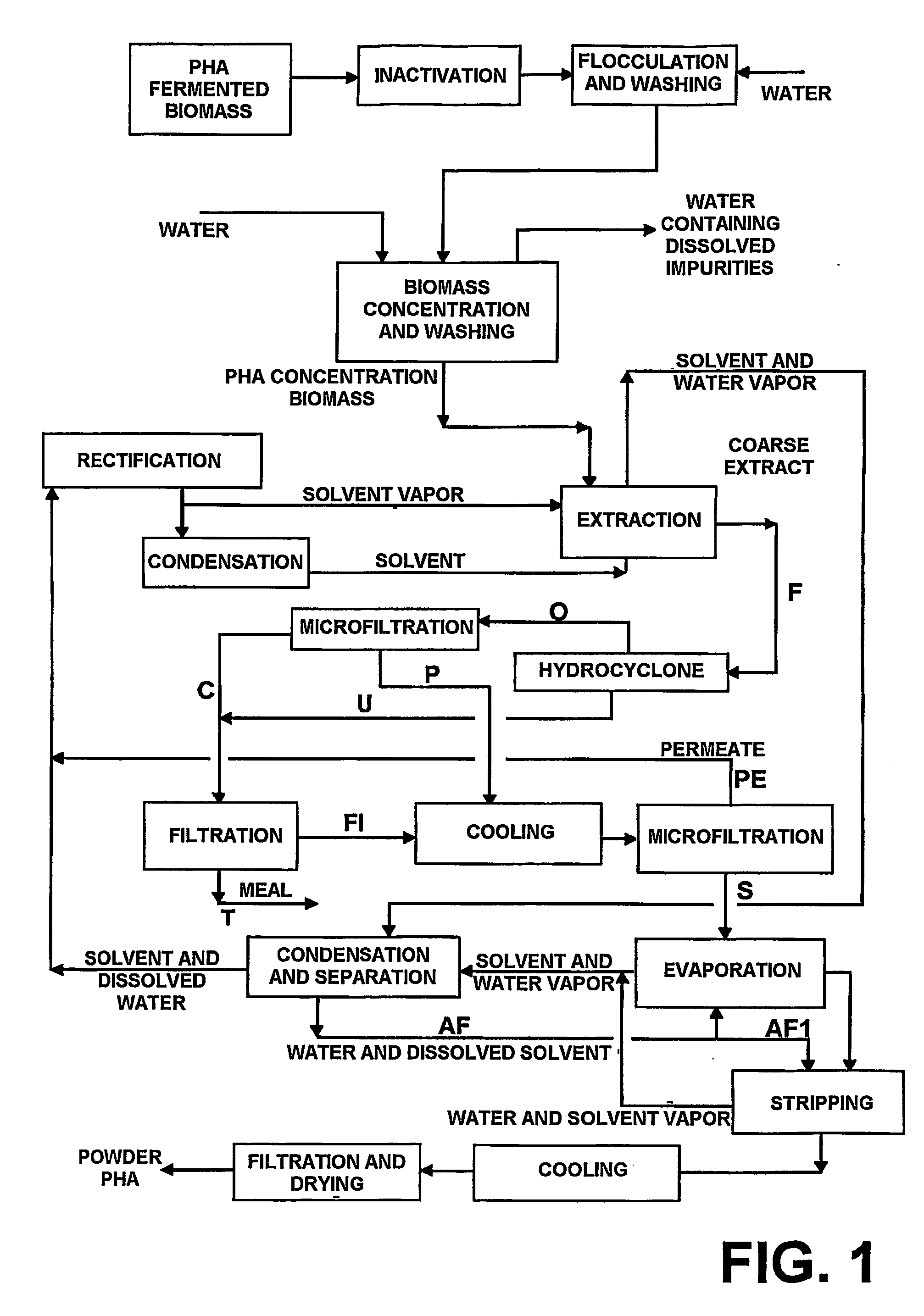Process for recovering polyhydroxialkanoates ("phas") from cellular biomass
- Summary
- Abstract
- Description
- Claims
- Application Information
AI Technical Summary
Benefits of technology
Problems solved by technology
Method used
Image
Examples
example 1.1
Inactivation of the Fermented Biomass
[0089] 10 m3 of a suspension of fermented biomass of Alcaligenes eutrophus, containing 150 g / l of total dry material, formed by bacterial cells containing about 60-75% PHB by weight, are passed through a regenerative heat exchanger TCR1 at a flowrate of 4 m3 / h, subsequently receiving direct injection of vapor, in order to increase the temperature to 85° C. This suspension is conducted to a retention vessel with useful volume of 1 m3 and pumped back to the exchanger TCR-1, where it is cooled by the biomass suspension, which enters in the process and is in turn heated. The biomass suspension, which leaves the process at about 45° C., maintains practically unaltered the concentrations of dry material and PHB. However, the bacterial cells have now their enzymatic system inactivated, and are therefore unable to degrade the accumulated PHB. This suspension is then conducted to the coagulation and decantation process.
example 1.2
Wash and Concentration of Fermented Biomass
[0090] To 5 m3 of previously inactivated PHB fermented biomass of Alcaligenes eutrophus, 5 m3 of water under mild agitation, and then phosphoric acid are added, until reaching pH of 2.8-3.5, and milk of lime until reaching pH 7.0-8.0. The coagulated biomass suspension then receives the addition of 10-20 ppm of an anionic polyelectrolyte, being slowly agitated and then maintained under rest for decantation. The supernatant is then removed, leaving a biomass slurry with about 10-12% dry material. The obtained slurry is then fed to a centrifuge decanter at a flowrate of about 1200 kg / h and then it further receives the addition of polyelectrolyte, in a sufficient quantity to flocculate, and water in a proportion of about 20% (weight / weight) of the fed slurry flowrate. The clarified material is then removed, generating about 2400 kg of slurry with about 20-25% solids from which 70-75% correspond to PHB.
example 1.3.1
PHB Extraction and Recovery Using Isoamyl Alcohol as Solvent in a One-Stage Extraction
[0091] The Alcaligenes eutrophus biomass concentrated at 25% dry material and containing about 60-75% PHB with molecular weight of 1,000,000 Da is fed to a mechanically agitated reactor, maintained at about 105° C. at a flowrate of 350-450 kg / h, in which it receives the addition of 7290 kg / h of isoamyl alcohol heated at about 105° C. and vapor of isoamyl alcohol at 135° C., in a sufficient quantity to evaporate the excess of water contained in the slurry, generating a stream of about 1250 kg / h of vapor composed of about 15% water and 85% isoamyl alcohol, and another stream denominated coarse extract of about 8000 kg / h of a suspension containing PHB (molecular weight of about 900,000 Da) and water dissolved in the isoamyl alcohol, and insoluble residues of extracted biomass. The coarse extract is then continuously fed to a hydrocyclone, where the flow is separated in two streams: one stream of abou...
PUM
| Property | Measurement | Unit |
|---|---|---|
| Fraction | aaaaa | aaaaa |
| Fraction | aaaaa | aaaaa |
| Percent by mass | aaaaa | aaaaa |
Abstract
Description
Claims
Application Information
 Login to View More
Login to View More - R&D
- Intellectual Property
- Life Sciences
- Materials
- Tech Scout
- Unparalleled Data Quality
- Higher Quality Content
- 60% Fewer Hallucinations
Browse by: Latest US Patents, China's latest patents, Technical Efficacy Thesaurus, Application Domain, Technology Topic, Popular Technical Reports.
© 2025 PatSnap. All rights reserved.Legal|Privacy policy|Modern Slavery Act Transparency Statement|Sitemap|About US| Contact US: help@patsnap.com



